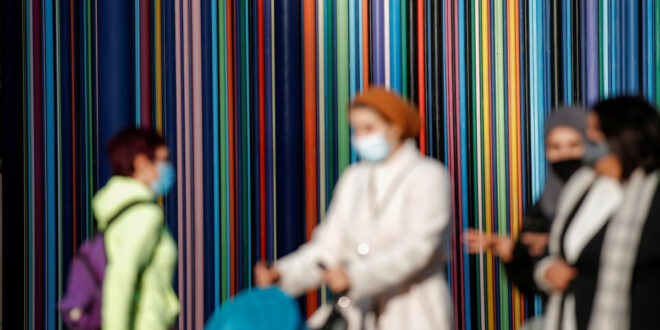We’ve repeatedly heard about how COVID-19 disproportionately impacts girls. Whereas males usually tend to die from the virus, in lots of different respects, girls are bearing the brunt of the pandemic’s influence.
The consequences on girls have been a number of: violence towards girls has elevated, with incidents of home violence hovering. Faculty closures, overburdened healthcare methods and social distancing measures have considerably elevated many ladies’s unpaid care and home hundreds at house, which, in flip, has made them much less capable of steadiness these duties with paid work.
Extra caring work from home has additionally meant that extra girls have been pressured to scale down or depart the workforce. Concurrently, girls, and notably girls of color, have been sacked or furloughed at the next fee throughout the pandemic, stalling their careers and jeopardising their monetary safety. And the listing goes on.
Media stories have constantly documented the pandemic’s devastating influence on gender equality. An article showing within the Atlantic reads: “The Coronavirus Is a Catastrophe for Feminism”, whereas a Monetary Instances article queries: “Is the coronavirus taking girls again to the 1950s?”
Such headlines matter as a result of they form how we take into consideration the problem. And right this moment, greater than ever, when individuals are likely to devour information rapidly, typically on their telephone screens, they’re extra prone to learn the headline and scan the textual content, slightly than learn phrase for phrase. But, now we have turn out to be so accustomed to those headlines that we not often pause and problem what ought to, actually, be apparent: they get the causality all mistaken.
The language used typically implies that the pandemic itself is chargeable for intensifying inequalities and for eroding girls’s rights. In reality, blaming COVID-19 for ladies’s deteriorating materials, financial, bodily, and psychological circumstances, has three hanging results.
First, it deflects accountability for rising inequality, finding it in “the pandemic”. Take the BBC Information headline: “5 methods virus upheaval is hitting girls in Asia”, or the Guardian’s subheading: “Identical to each emergency, COVID-19 is racist, ageist, classist and sexist”. This sort of framing implies that the coronavirus has its personal company.
Second, blaming the virus produces and reinforces a way of fatalism, intimating that the large blow to girls, the poor and the weak in society is inevitable because it has been brought on by a pure power past our management. Statements like “the pandemic will take girls 10 years again” or “the pandemic is destroying girls’s rights”, which have been repeated even in probably the most progressive media retailers, suggest not solely that rising inequality is the pandemic’s “fault”, however that it has additionally been inevitable.
Third, headlines and statements like these create the misunderstanding that earlier than the pandemic girls’s circumstances have been bettering apace. They counsel that the pandemic has quickly reversed many years of regular progress vis-à-vis gender equality – as if previous to March 2020 there have been few setbacks, not to mention retrenchments. This obscures the truth that issues have been already profoundly unequal earlier than the pandemic struck.
To be clear: the intention of many media stories is clearly to spotlight the worsening of gender inequality and the urgency of addressing it. But their framing too typically diffuses duty and reinforces a sense of inevitability. And this wants to vary.
Slightly than blaming the “pandemic”, we’d like reporting – together with headlines – that clearly identifies the foundation causes of gender inequality in order that we are able to apportion duty the place it really belongs and mobilise to impact concrete change. Step one is to call the forces chargeable for rising inequality.
As an example, slightly than speaking in regards to the “pandemic” inflicting the dramatic rise in home violence, media statements can establish the deadly dynamic of poverty, girls’s financial dependence alongside dominant norms round gender, all of which have been severely aggravated post-COVID, whereas highlighting the shortage of applicable sources for important providers like gender-based violence refuges, helplines, and routine well being checks.
As an alternative of decrying how tens of millions of girls are pressured to stop their jobs due to COVID-19, headlines have to underscore that ladies, and particularly moms, have been pushed out of the workforce due to the failures on the a part of governments, establishments and workplaces to help them.
Second, we should situate the pandemic’s disastrous influence on girls throughout the broader context of our modern disaster of care. What we’re witnessing now’s neither as sudden nor sudden as these stories typically suggest. Previous to March 2020, girls within the UK, as an illustration, have been already extra prone to be dwelling in poverty, notably as they make up nearly all of single dad and mom, single aged individuals, and people with caring duties, which then restrict their time for paid work. Girls have been additionally over-represented in insecure, precarious employment and within the low-paid sectors hardest hit by the pandemic, equivalent to hospitality, leisure, retail and tourism.
Thus, after we hear that “Tens of millions of profession girls are contemplating giving up work as a result of stress of juggling their jobs with childcare and family chores in lockdown,” it’s essential that we’re reminded that earlier than the pandemic, gender inequality within the office was rife in most nations. Within the UK, for instance, earlier than the pandemic, the gender pay hole was already holding regular at eight.9 % for these in full employment, and 17.three % for all workers.
Lastly, we should urgently substitute fatalistic sentiments with daring calls for and swift motion on a mass scale.
We’ve roadmaps to attract on. The Girls’s Price range Group, as an illustration, has known as for a radical transformation of our financial system: from one which prioritises revenue over individuals to at least one the place there are ample sources for high-quality care providers in order that moms in waged employment are supported, and the place dwelling wages and protected working circumstances are assured for all. Equally, the Care Manifesto, printed this 12 months, calls for that we roll out common care on all scales of our lives, from our most intimate to the planetary.
If we’re really dedicated to countering gender inequality and the deteriorating circumstances of so many ladies’s lives, we should be sure that these and comparable pressing calls for make the headlines.
The views expressed on this article are the authors’ personal and don’t essentially replicate Al Jazeera’s editorial stance.
 Top Naija News: Nigerian News, Breaking News Nigeria and World News Top Naija News is a daily news publication in Nigeria, delivering the latest breaking news in Nigeria and around the world.
Top Naija News: Nigerian News, Breaking News Nigeria and World News Top Naija News is a daily news publication in Nigeria, delivering the latest breaking news in Nigeria and around the world.




